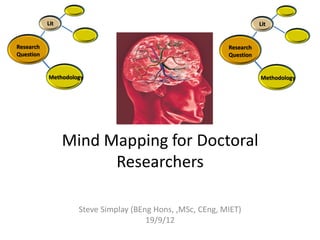
Advanced mindmapping for research slideshare
- 1. Lit Lit Research Research Question Question Methodology Methodology Mind Mapping for Doctoral Researchers Steve Simplay (BEng Hons, ,MSc, CEng, MIET) 19/9/12
- 2. Overview • History of mind mapping? • 3D View of the Brain • Creativity studies • What is a mindmap? • Benefits of a mindmaps? • Mindmap parts / creation • Example 1 • Example 2 • Questions?
- 3. History of mind mapping? • Tony Buzan was born in London 1942, and graduated from the University of British Columbia 1964. • While developing his understanding of the human mind he studied psychology, neuro-physiology, neuro – linguistics, semantics, information, etc. • In 1971, he realized that through a computer came a manual, the human brain much more powerful than computers. • Radiant thinking of the brain
- 4. 3D view of the Brain Source - Lumos Labs
- 6. What is a Mindmap? • A mindmap is a visual way of organizing ideas in a web-like structure.
- 7. Why mindmap? • Use right brain (visual, intuitive) as well as left brain (logical, linear) • Make new connections between ideas • Fast and easy to create • Easy to learn • Capture every connection • Fun to do
- 8. Mindmap Parts / Creation • Center word / image • Branches • Sub-branches – less important info • Add sub-branches, associate ideas • Single keywords / phrases • Images and color
- 9. Benefits of Mindmaps • Visual • Easy to connect “distant ideas” • Easy recall of information • Brain dump first, then easy to rearrange ideas • Creative thinking
- 10. Example 1
- 11. Example 2
- 12. Questions